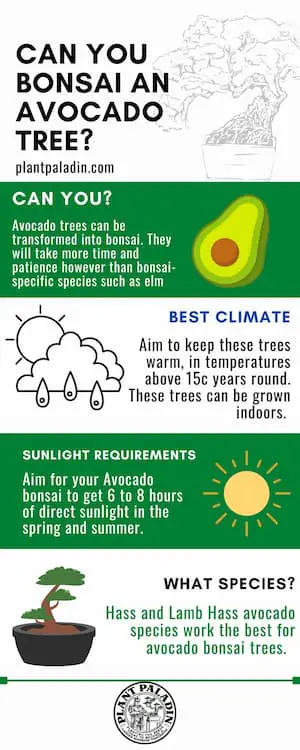This website is supported by its readers. If you click one of my links I may earn a commission. I am also a participant in the Amazon affiliates program and I will also earn a commission from qualified purchases.

One of the reasons why bonsai is so popular is that you can transform most plants and trees into bonsai trees. Fruit trees such as Cherry, Apple, or Crabapple are all commonly used in the art of bonsai. One fruit, however, that you don’t hear too frequently transforming into bonsai are Avocados. So can you bonsai an Avocado tree?
You can bonsai an Avocado tree. They will, however, require more time and patience to grow than other fruit bonsai trees, such as apple or cherry bonsai. Grow in bright, warm conditions with plenty of moisture for best results.
So how exactly can you grow an avocado bonsai tree step by step? And what are some general care tips for your avocado tree bonsai? Keep reading to find out more!
Just a quick heads up, over the past three years of running Plantpaladin, hundreds of people have asked for product recommendations. As such, You can find my favorite indoor bonsai tree here (link takes you to Bonsaiboy), my favorite outdoor bonsai tree (link takes you to Bonsaiboy), or have a look at all the products I recommend here.
Can you bonsai an avocado tree?
With over 500 sub-species, avocados have shot up in popularity in the past decade or so.
Making up a crucial part of many a millennial’s breakfast, the demand for avocados and avocado trees has never been higher.
One area, however, that avocados still need to conquer is bonsai trees.
After all, with other fruit bonsai such as Lemon, Lime, Orange, Apple, Cherry, and Crabapple all being commonplace, why don’t we hear too much about avocado bonsai?
To get to the bottom of this and see if you can bonsai an avocado tree, I contacted my local botanical gardens and a few experts and even surveyed ten bonsai hobbyists here at Plantpaladin.
To summarize:
- You can transform avocado trees into bonsai. They will require slightly more time and patience than other fruit trees and trees commonly used in bonsai.
- The main reason for this is the location where avocados are grown. The vast majority of Avocados are native to South America.
- This means only conditions similar to avocado trees’ native territory will thrive.
- Your tree will require much sunlight, warm conditions, and moisture to thrive.
- Particular attention must also be paid to pruning and pinching back an avocado bonsai.
- This is because the leaves of avocado trees are notorious for growing large, so these will need to be trimmed to create an aesthetically pleasing avocado bonsai.
- The best avocado tree species for your avocado bonsai will be Hass or Lamb Hass varieties, as these are the most commonly found avocados and are more beginner friendly.
Avocado bonsai – Quick care guide:
Avocado bonsai tree requirements | Explained |
Water | Water your avocado bonsai two to three times per week when the topsoil is dry. More watering may be required during hot, dry summers. |
Sunlight | Direct sunlight for 6 to 8 hours per day during the spring and summer. Place in the shade/semi-shade during the brightest weeks of the year. |
Temperature | Between 60 degrees F and 80 degrees F. However, they can survive in warmer and cooler conditions for limited periods. |
Fertilizer | Fertilize with organic fertilizer 2 to 3 times per year. |
Repotting | Once every one to two years. |
Placement | Outdoors during the spring, summer, and fall if temperatures are warm. Indoors during the winter or if temperatures are below 60F for more than a few days. |
Species Type | Evergreen. |
Wire type | Both copper and aluminum |
Time to grow from seed | five years |
Potting Soil | Inorganic mix of akadama and volcanic ash rock. |
Growth-type | Medium adds 5 to 12 inches of growth per year. |
Size | Medium to large; most Avocado bonsai trees will work best at this size. |
Lifespan | 100 to 500 years if used for bonsai (200 to 400 years if not used for bonsai) |
Pests | Borer, aphids, scale, caterpillars, gall makers, commonly affect Avocado bonsai |
Fruit | Produce avocados; however, this will only be undertaken if the leaves are large enough., Avocado bonsai then will rarely produce avocados. |
How to bonsai an avocado tree?
So now we know it’s possible to grow an avocado bonsai? What is the exact step-by-step process of growing an avocado bonsai?
Luckily, as mentioned, I got in touch with ten plant paladin readers who have grown out their avocado bonsai trees and provided me with the following steps to grow the perfect avocado bonsai:
- Ensure it’s the right time of year.
- Come up with a design.
- Decide how large you want your tree to grow.
- Gather your avocado seeds/stone or use a cutting.
- Invest in suitable potting soil.
- Plant your avocado in potting soil.
- Grow your avocado trees as a regular tree in its first year or two.
- Repot your tree and start the bonsai process.
- Remove the excess leaves.
- Develop your trunk
- Wire your tree
- Prune the bonsai
- Repeat the process.
Let’s explore this in more detail.
Ensure it’s the right time of year.
So before we start growing our avocado bonsai, there is a bit of housekeeping you need to get out of the way.
Because the leaves of avocado bonsai grow so large, we need to grow our avocado tree as a regular avocado tree for a year or two before transforming it into a bonsai.
To do this, you must note the time of year.
Why?
Well, avocado trees are native to South America.
As such, most of you reading this (myself included) live in much colder environments.
You need to ensure that if we are growing these trees from scratch, you plant them between March and June to replicate best the natural cycle an avocado tree will grow.
Come up with a design.
The second step, regardless of the type of bonsai tree you are growing, is to develop a design.
While your bonsai will likely look different from your design if growing from scratch for a few years, it’s essential to have a plan of what you want your tree to look like to help give you something to aim for.
At this stage, you can decide what style (sumo, cascade, semi-cascade) you want your avocado bonsai tree to look like.
Remember that you can always amend this as you get deeper into your bonsai journey.
Decide how large you want your tree to grow.
Avocado bonsai trees can be relatively fast-growing, specifically in the summer.
Particular care needs to be taken when growing these trees. Especially their leaves, which can become large and cumbersome.
At this early stage, determine the size classification you would like your avocado bonsai to grow out.
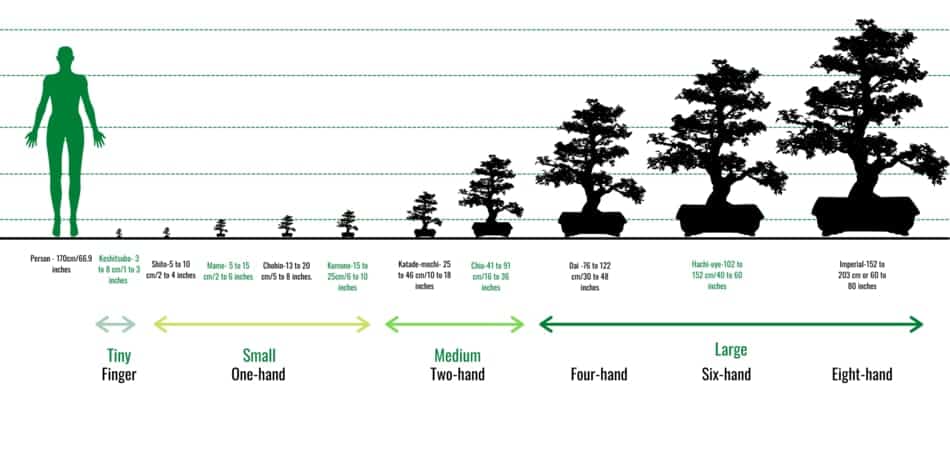
For most species, growing these at a maximum size of one or two-handed bonsai trees will allow these trees to be the most manageable.
Gather your avocado seeds or use a cutting.
So now that we have the housekeeping out the way, it’s time to start growing your avocado bonsai.
Now there are two main ways to do this:
Growing from scratch will take much longer but can be more rewarding.
Using a cutting, however, will be a much easier and faster way to grow your avocado bonsai, so I highly recommend this option.
Growing avocado Bonsai with a seed
If you have decided to use the seed method, then you need to follow a few additional steps.
While most bonsai trees grown from scratch, such as Oak trees grown from acorns, need cold stratification, Avocados need warmth to sprout instead.
To grow from seed, purchase your avocado seed online or carefully remove an avocado stone.
Wash using warm water to remove any excess avocado juice.
Then dry thoroughly and fill a cup of water with warm water.
Gently pierce the avocado with four toothpicks and suspend it above a cup of water, so the base of the avocado is touching the water.

Then provide ample warmth and sunlight (using a grow light if kept indoors), and after about six weeks or so, your avocado will have sprouted.
Growing avocado bonsai with a cutting
Growing using a cutting is much easier.
Trim off a branch from an existing avocado tree.
Remove the bottom of the branch until the inner wood is exposed.
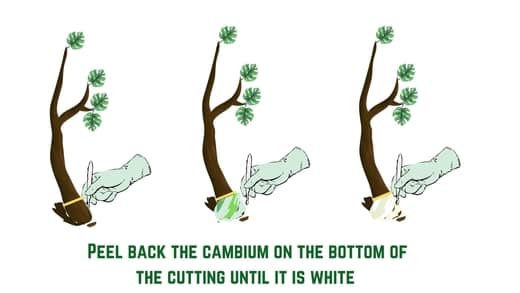
Then treat with root hormone, and place in water in a warm space for a few weeks.
New roots should then form, and you can the cutting in a new pot.
Invest in suitable potting soil.
At this stage, you should have either an avocado seed with some new shoots growing out of it or a cutting with new roots.
Your avocado trees are now ready to be planted.
Another critical difference between traditional avocado bonsai trees and other bonsai varieties is that you will need to grow your avocado bonsai as an average tree for the next year or so before transforming into a bonsai.
To do this, instead of going straight into an inorganic bonsai soil mix of akadama, volcanic ash rock, and grit, we will opt for traditional avocado soil.
Aim then for regular peat soil or compost soil that is loose, loamy, or sandy with a neutral soil PH level of around 7.
Plant your avocado cutting/seed.
Next up, plant your avocado cutting or seed.
To do so, avoid planting in a regular bonsai pot for now ( that will come later) and instead plant in a standard pot that is both large and deep and will give the roots of your avocado tree plenty of room to grow.
Grow your avocado bonsai as a regular tree.
Once your tree has been planted, just let it grow.
This is because if you try modifying or training your avocado tree at this stage before it can grow any branches or gain any size, you will likely end up killing your tree.
Avocado trees differ slightly from other bonsai because of their large waxy leaves.
It’s a catch-22 situation in the sense that you need your avocado tree to grow before we can start training it, but we don’t want the avocado tree to grow massive leaves.
At this stage then, move your avocado tree into a bright warm spot.
If you live in a climate with warm conditions, you can place this directly outside.
Alternatively, if you live in a mild climate, grow your avocado tree indoors in a warm room with plenty of light, such as on a windowsill.
You can even grow your avocado tree in a greenhouse to ensure it gets the right temperature it needs to thrive.
In terms of general care, we will cover this later in the post, but summarize:
- Water the avocado or check for watering 2 to 3 times per week.
- Feed your avocado tree with plant food once weekly during spring and summer.
- Check for signs of gnats, borers, or aphids regularly to keep your avocado tree healthy.
Aim to continue this process for a year or two until your avocado tree is around 15cm to 30cm tall.
We can then move on to the bonsai process.
Repot your tree and start the bonsai process.
So you now have a small avocado tree but are likely wondering why this looks different from a bonsai tree.
The next few steps will transform the current avocado tree into a full-fledged bonsai tree.
The first thing we need to do then moves our avocado tree from its current pot into a new shallow bonsai pot.
To do this, use a hook or hook-like tool to go around the edge of the pot.
Prying the avocado tree loose.
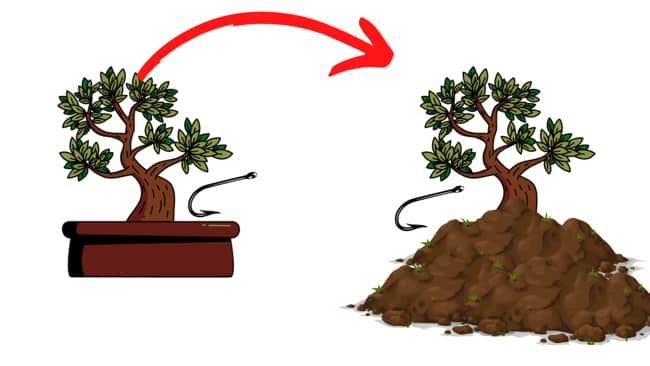
Then expose its roots and trim any dead or damaged roots until only a few remain.
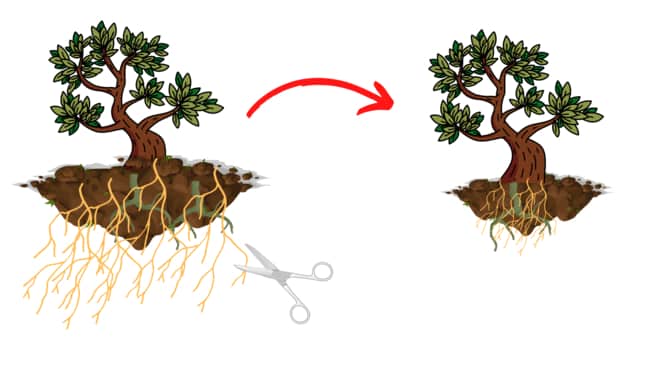
Then, in your new bonsai pot, add wire mesh to the holes at the bottom and secure them with wire.
This will help with moisture retention and moisture flow when you water your bonsai.
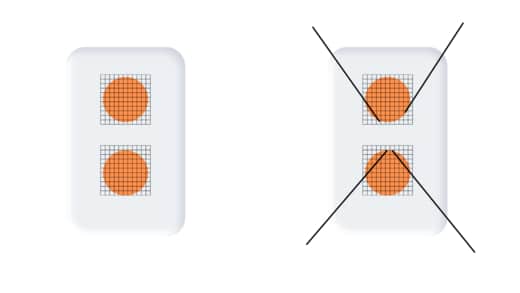
You then want to thread a copper or aluminum wire through the mesh to help hold your bonsai in place.
Fill up the bottom around halfway with potting soil ( ideally an inorganic mix of volcanic ash rock, pumice, or akadama).
Gently place your avocado tree into the new pot.
Secure with the wire you threaded through, then fill the pot with the remainder of the inorganic bonsai soil.
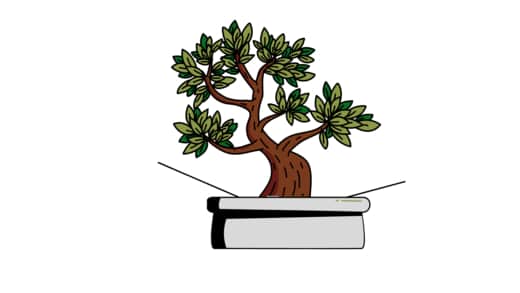
Let your tree rest in the new pot for about a month before you move on to the next step, as reporting can be very stressful on bonsai trees.
Remove the excess leaves and branches.
After a month of repotting (or as much time is required for your tree to recover from the repotting process), you will need to trim back the avocado bonsai leaves.
At this stage, the leaves will likely be huge. Some avocado leaves can grow to over ten inches.
Use a pair of bonsai sheers or scissors and then trim these back at the petiole.
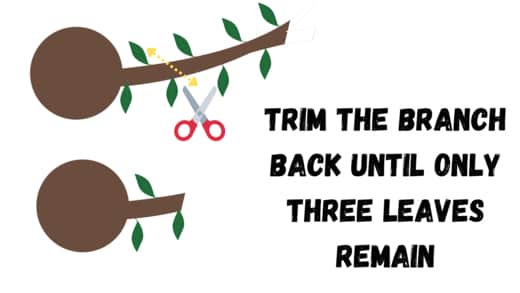
Remove until around 70% of the leaves have been defoliated.
You will then be left with a tree with very few leaves. (Be careful, however, not to over-prune)
At this stage, your branches will be much easier to get to, so trim back the branches of your bonsai tree to develop secondary and tertiary branches with significant ramifications.
Develop your trunk
Now your avocado bonsai has been repotted into a larger pot; you can start making it look like an actual bonsai tree.
The best palace to start with this would be by creating a more expansive, thicker tree trunk with plenty of movement and shape.
Avocado bonsai trees typically have fat trunks to help best replicate what avocado trees will look like in the wild, so this will be our first point of contact.
This can be undertaken in three main ways:
- Bonsai trunk chopping – used to add taper to your tree
- Bonsai trunk bending – used to add bends to your tree. This is particularly useful for styles like cascade, semi-cascade, or informal upright bonsai styles, which have a lot of movement.
- Growing out a sacrifice branch – This will thicken up the size of the tree’s trunk over a few years by growing out an excess branch.
As this process can be challenging, I recommend looking at my post on the topic here.
Just be aware that developing a solid trunk takes time, and it can take 5 to 10 years from when you first start creating your avocado bonsai until it starts to develop into the trunk you desire.
Wire your tree
After a few years of tree trunk development, you will have a strong tree trunk resembling a bonsai tree.
Next, you need to undertake the same process for the branches of your tree.
This will help move the branches into the positions which will best mimic avocado trees in the wild and be as aesthetically pleasing as possible.
This is undertaken through wiring your bonsai – again, another complicated process that I have gone into more detail on here.
To wire your avocado bonsai:
Remove any excess foliage from your tree to make it easier to see the branches you are wiring – you can do this with a sharp pair of scissors.
Select the branches of your tree that can be single-wired, and then wrap copper or aluminum wire around the trunk of your tree at a 45-degree angle for support and then at a 45-degree angle around the branch you are wiring.
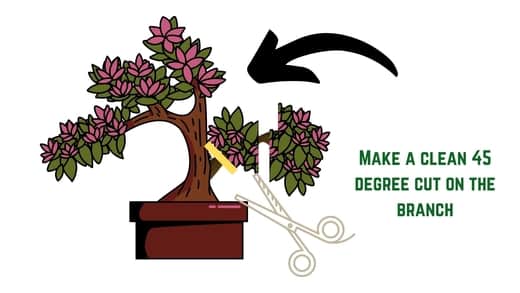
Single wire any secondary or tertiary branches.


For the remaining branches that are near each other, you can double-wire these.
Wrap your wire around the middle part of the trunk to reach multiple branches, then wrap the branches at a 45-degree angle.
You can then move your branches into their new position.
Remove the copper wire with shears after 6 to 8 weeks – your branches will then be set into their new position.
Prune the tree
Once your Avocado bonsai tree has been wired, you can then prune the tree using a sharp pair of scissors.
Aim to cut back branches or leaves that take away from the silhouette of the tree design.
Ensure you regularly check your tree every few weeks for signs of new growth and trim them back if necessary.
Alternatively, if you want to speed up the rate at which your tree is sprouting leaves or enable new growth for a larger-sized bonsai, consider defoliating the leaves of your oak tree bonsai.
This creates a much thicker, denser canopy, leading to more significant bonsai ramifications.
I aim to do this every few weeks for my bonsai – see it as taking your bonsai tree to their hairdressers to stop things from getting out of hand.
Repeat the process
Getting this far is only half the journey, and you will likely have to repeat the steps of repotting, developing the trunk, wiring, and pruning in a cycle every few years to achieve a bonsai you can be proud of.
Benefits of avocado bonsai
There are many steps required to care for an avocado bonsai tree, so are there any advantages over other common bonsai species?
The most significant benefit of avocado bonsai is that they are uncommon.
This means that if you have an extensive collection of bonsai trees, this will stand out in the eyes of bonsai enthusiasts.
Avocado bonsai trees are also relatively low maintenance, only needing to be watered a few times weekly.
Drawbacks of avocado bonsai
First, these trees could be more beginner friendly as you often grow them out of their climates.
Secondly, as these trees are tropical, they require a tropical blend of sunlight, heat, and moisture which can be more challenging to find in temperate climates.
Their leaves also can grow incredibly large, meaning you will be defoliating these trees much more frequently than other species.
Finally, as these trees are used less commonly in the art of bonsai, the amount of knowledge to care for these trees will be much more limited than the other common bonsai trees such as Maple, Oak, or Elm trees.
FAQs on Avocado bonsai
What Avocados work best for avocado bonsai?
Hass or Lamb Hass avocados work best for avocado bonsai trees. This is because these varieties of avocado are commonplace and will be the easiest to propagate as compared with rarer avocado species.
Are Avocado bonsai beginner friendly?
Creating an avocado bonsai is not beginner friendly and should be avoided if this is your first bonsai tree. This is because many of you will be growing these trees out of season in a climate not native to the species. Chinese Elm, Ficus, or Fukien Tea are all more beginner friendly than avocado bonsai.
Can you grow an avocado bonsai from seed?
Avocado bonsai can be grown from seed, which will take significantly longer than a cutting. Pierce the seed with four toothpicks and hover a glass of water with the base touching water for the best results to help propagate the seed.
Sunlight and location requirements for avocado bonsai.
Avocado bonsai trees require at least 6 to 8 hours of direct sunlight daily. For best results, place them in your garden in a bright spot. Alternatively, if growing indoors, place it near a south-facing window or use a grow light to provide the sunlight required.
Water requirements for Avocado bonsai.
Avocado bonsai must be watered two to three times per week. To check, place your index finger in the potting soil. If dry to the touch, then water the tree. If moist, you can avoid watering it for that day.
Ensure your avocado bonsai goes up to one week without watering.
Check a few times per day during sweltering summers.
Ensure, however, that you do not overwater your avocado bonsai.
Overwatering can lead to root rot or fungal infections in avocado bonsai.
Aim to water avocado bonsai with rainwater where possible and avoid using tap or bottled water, which can contain contaminants such as calcium which can alter the soil’s PH Levels.
What is the best potting soil for avocado bonsai?
The best potting soil for avocado bonsai would be an inorganic mix of 30 % pumice, 40% akadama, and 30% volcanic ash rock. Organic material such as peat or sphagnum moss can also be added to make up at most 25% of the potting soil mix.
Aim to keep the soil at a neutral PH level.
The expedition to this would be when growing your avocado tree in its first year or two when regular avocado soil can be used.
How often should you fertilize avocado bonsai?
Avocado bonsai should be fertilized twice to thrice yearly during the spring, summer, and fall. Ensure the fertilizer has an even N-P-K ratio not to impact the soil PH.
Plant food can be used every few weeks on avocado bonsai during the growing season (spring/summer)
What is the best temperature to keep avocado bonsai?
Avocado bonsai prefer warm, humid conditions. Aim to keep avocado bonsai between 60F and 80f (15c to 26c). Ensure temperatures do not drop too cold, which can kill the tree, or do not exceed 90F for too long).
Do avocado bonsai produce avocado?
It is rare for avocado bonsai to produce avocados. Avocado bonsai will typically keep its large leaves trimmed. These larger leaves are essential for growing fruit and will not have the energy or sunlight needed to produce fruit.
How fast do avocado bonsai grow?
Avocado bonsai trees grow at a medium speed, typically adding 5 to 12 inches of new growth every year during the spring and summer. These trees take 3 to 5 years to grow from seed before you can actively work on them as bonsai trees.
How long do avocado bonsai trees live?
Avocado bonsai trees can live for 100 to 400 years if kept in perfect condition. Most avocado bonsai trees, however, will typically live for 20 to 50 years old.
What pests attack avocado bonsai?
Borers, Aphids, Scale, Caterpillars, and Gall Makers, commonly affect Avocado bonsai. To prevent, use parasitic insects such as ladybirds or wasps or use pesticides such as liquid soap and water to remove them.
Survey results
Finally, as mentioned, I asked ten plant paladin readers if you can bonsai an avocado tree.
Here are the results:
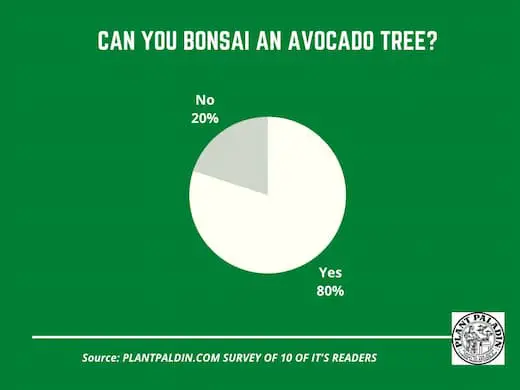
My top picks for the gear you will need!
So like I mentioned earlier, over the past three years of running PlantPaladin, hundreds of people have asked me for my recommendations on the best bonsai gear on the market.
Having spent thousands of dollars on bonsai items these past few years and tested at least 100 bonsai-specific products, I’ve listed my favorite products below – All of which I highly recommend and think you can get great value.
They can purchase directly by clicking the link to take them to Amazon.
Bonsai Tool Set: One of the significant challenges I’ve had is finding a toolset that was not only durable but didn’t break the bank. SOLIGT has recently developed a fantastic bonsai tool set that covers all the tools you need to trim, prune, and repot your trees. – You can grab it here.
Complete Bonsai Set: Many of you will want to grow your bonsai trees entirely from scratch, but finding the varicose seeds, pots, and other items in one place can be challenging. Leaves and Sole then have created a complete bonsai set that I’ve personally used that ticks all the boxes. You can grab it here.
Bonsai wire: The number of times I’ve run out of wire for my bonsai or purchased cheap bonsai wire that doesn’t do the job is embarrassing for me to admit. After a lot of trial and error, I found that using Hotop’s aluminum bonsai wire is one of the best options on the market. This can easily be used for both indoor and outdoor bonsai. You can grab it here.
This post was written by Fehed Nicass, who has been passionate about bonsai and gardening for over three years.

